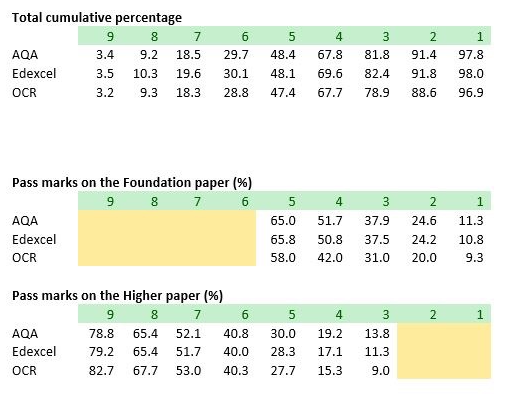Below are collections each containing 20 questions. These print out one question to an A4 sheet and are intended to be given to students for a longer term revision activity. Perhaps one collection per week if no other homework is being assigned. The same questions appear in the Practice Papers above as appear in the Question Collections below as it is not expected that students will do both.

1
Finance
Probability
Mensuration
Proportion
Finance
Construction Mensuration
Angles
Algebra
Trigonometry
Sequences
Exponential Models
Probability
Simultaneous Equations
Statistics
Exponential Models
Proof
Proportion
Mensuration
Finance
Proportion

2
Algebra
Ratio
Probability
Functions
Similarity
Congruency
Proof
Surds
Standard Form
Proportion
Statistics
Angles
Combinations
Combinations
Mensuration
Iteration
Proof
Transformations Vectors
Proportion
Probability

3
Ratio
Algebra
Probability
Number
Approximation
Mensuration
Graphs
Sequences
Kinematics
Circle
Box Plots
Surds
Algebra Proof
Trigonometry
Vectors
Ratio Simultaneous Equations
Graphs
Mensuration
Algebra Inequalities
Number

4
Finance
Probability
Statistics
Indices
Proof
Algebra
Kinematics
Sets
Similarity
Trigonometry
Graphs
Fractions
Mensuration Similarity
Algebra
Pythagoras
Transformation of Graphs
Iteration
Vectors
Kinematics
Probability

5
Trigonometry
Functions
Statistics
Algebra
Ratio
Trigonometry
Indices
Cumulative Frequency
Proof
Percentages
Angles
Angles
Approximation
Construction Loci
Probability
Percentages
Graphs
Graphs
Probability
Bearings

6
Bearings
Trigonometry
Vectors
Recurring Decimals
Kinematics
Algebra Proof
Circle
Mensuration
Algebra
Statistics
Transformations
Mensuration
Simultaneous Equations
Ratio Standard Form
Percentages
Mensuration
Pythagoras
Circle Equations
Circle Equations
Graphs

7
Graphs
Proportion
Proportion
Statistics
Percentages
Statistics
Algebra
Correlation
Algebra
Sequences
Trigonometry
Averages
Mensuration
Probability
Transformations
Circle Equations
Inequalities
Circle
Approximation
Iteration

8
Trigonometry
Algebra
Inequalities
Inequalities
Ratio
Combinations
Finance
Box Plots
Equations
Mensuration
Trigonometry
Compound Units
Angles
Ratio
Probability
Simultaneous Equations
Sets
Circle Equations
Sequences
Mensuration

9
Graphs
Algebra
Indices
Mensuration
Proof
Circle Theorems
Graphs
Histogram
Probability
Equations
Standard Form
Transformations
Cumulative Frequency
Error Bounds
Finance
Similarity
Kinematics
Plans and Elevations
Ratio
Probability

10
Trigonometry
Mensuration
Geometric Proof
Simultaneous Equations
Vectors
Graphs
Probability
Proportion
Indices
Graphs
Graphs
Pythagoras
Algebra
Algebra
Inequalities
Number
Correlation
Functions
Inequalities
Indices

11
Volume
Proof
Graphs
Ratio
Inequalities
Trigonometry
Number
Percentages Inequalities
Circle Theorems
Algebra
Ratio
Functions
Factorising
Probability
Box Plots
Kinematics
Frequency Tree
Loci
Kinematics
Angles

12
Averages
Indices
Algebra
Graphs
Congruency
Congruency
Sequences
Ratio
Inequalities
Vectors
Standard Form
Changing the Subject
Bearings
Probability
Inequalities
Error Bounds
Shape
Probability
Angles
Ratio

13
Indices
Averages
Proportion
Graphs
Depreciation
Speed
Graphs
Angles
Approximation
Inequalities
Sequences
Graphs
Graphs
Trigonometry 3D
Quadratics
Proof
Probability
Ratio
Number
Plans and Elevations

14
Transformations
Ratio
Mensuration
Approximation
Fractions
Simultaneous Equations
Trigonometry
Similarity
Box Plots
Proof
Volume
Algebra Ratio
Combinations
Surds
Completing The Square
Proportion
Functions
Probability
Inequalities
Graphs

15
Statistics
Volume
Trigonometry
Error Bounds
Ratio
Standard Form
Similarity
Changing the Subject
Probability
Cumulative Frequency
Circle Measurements
Algebra
Kinematics
Graphs
Ratio
Angles
Trigonometry 3D
Vectors
Sets
Finance

16
Statistics
Graphs
Angles
Mensuration
Calculator
Pythagoras
Proportion
Percentages
Standard Form
Indices
Compound Units
Mensuration
Transformation of Graphs
Quadratic Sequence
Graphs
Algebra
Error Bounds
Simultaneous Equations
Histogram
Geometry

17
Bearings
Simultaneous Equations
Factors
Sets
Ratio
Graphs
Trigonometry
Vectors
Pythagoras
Percentages
Box Plots
Simplifying
Combinations
Trigonometry
Graphs
Trigonometry
Mensuration
Transformations
Quadratic Sequence
Quadratic Graphs

18
Mensuration
Iteration
Probability
Transformations of Graphs
Equation of a circle
Algebra
Speed
Error Bounds
Area
Probability
Graphs
Averages
Probability
Mensuration
Standard Form
Transformations
Algebra
Inequalities
Circle Theorems
Decimals

19
Speed Time Graph
Histograms
Error Bounds
Enlargements
HCF and LCM
Ratio Algebra
Holiday
Correlation
Finance
Graphs
Cumulative Frequency
Algebra
Mensuration
Sets
Probability
Mensuration
Graphs
Proof
Statistics
Ratio and Percentage Change

20
Algebra
Equations
Trigonometric Equations
Functions
Mensuration
Volume
Graphs
Calculus
Trigonometry
Venn Diagrams
Probability
Probability
Algebra
Quadratic Equation
Inequalities
Construction
Indices
Functions
Bearings
Mensuration
More exam-style questions
The more common formulae are no longer given in the exam paper. Here is a Formulae Sheet to memorise.
Performance in the GCSE exams is measured using grades 9 to 1 instead of the previous grades A to G. The following diagram shows roughly how the grades compare:
New grades

Old grades
When the first cohort received their results in August 2017 one of my former colleagues, Paul Metcalf (@PaulMetcalf123), analysed the data and produced the following summary:
Comparison of statistics for new GCSE examinations in June 2017.

The exam-style questions appearing on this site are based on those set in previous examinations (or sample assessment papers for future examinations) by the major examination boards.
The wording, diagrams and figures used in these questions have been changed from the originals so that students can have fresh, relevant problem solving practice even if they have previously worked through the related exam paper.
#
The solutions to the questions on this website are only available to those who have a Transum Subscription.
Exam-Style Questions Main Page
To search the entire Transum website use the search box in the grey area below.
Comments:












Transum,
Wednesday, July 26, 2017
"An informative newspaper article in the Ipswich Star explained the nine to one grades just before the first set of results were announced.
This was taken from an article in the Ipswich Star."